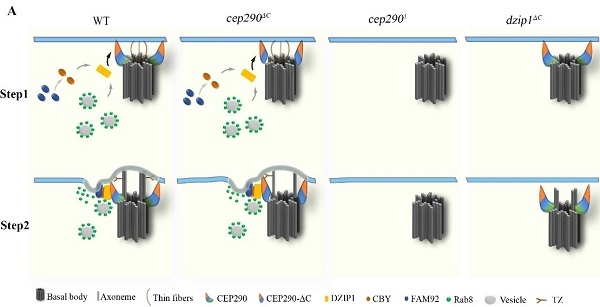Researchers Reveal Novel Function of Ciliopathy Protein CEP290 in the Initiation of Ciliogenesis
Date:15-01-2021 | 【Print】 【close】
Cilia are ubiquitous in human tissues, and the dysfunction of cilia can cause many organ defects and lead to over 35 kinds of human genetic diseases, collectively termed as ciliopathy.
The transition zone (TZ), a conspicuous structure at the ciliary base where many ciliopathy proteins localize at, is a diffusion barrier to gate the ciliary compartment. The evolutionarily conserved TZ component CEP290 is the most frequently mutated human ciliopathy gene, but its roles in ciliogenesis are not completely understood.
Recently, Dr. WEI Qing’s group from Shenzhen Institute of Advanced Technology (SIAT) of the Chinese Academy of Sciences reported that ciliopathy protein CEP290 was essential for the initiation of ciliary TZ assembly.
The study was published in the journal PLOS Biology, December 28, 2020.
By using Drosophila as a model organism, the researchers employed CRISPR/Cas9 mediated genome engineering technique and generated a putative null mutant of cep290. They found that, different from reported cep290 C-terminal deletion mutants, ciliogenesis blocked at the stage of TZ assembly initiation in cep290 null mutants, indicating that CEP290 plays an essential role for the initiation of TZ assembly.
In order to elucidate the role of CEP290 in TZ assembly initiation, the researchers employed the yeast two-hybrid assay to search for TZ related proteins that interact with the N-terminus of CEP290 and identified DZIP1. DZIP1 localizes to the TZ in Drosophila. They found that CEP290 was required for the TZ localization of DZIP1 and dzip1 deletion mutant mimiced the phenotype of cep290 null mutant. Interestingly, expression of the N-terminus of CEP290 alone restored the TZ localization of DZIP1 and subsequently ameliorated the defects of TZ assembly initiation in cep290 null mutants. Furthermore, the researcher demonstrated that ciliary membrane formation regulators CBY and Rab8 acted downstream of DZIP1 and jointly contributed to TZ formation.
Taken together, the researchers proposed that the N-terminus of CEP290 directly recruits DZIP1, which then recruits CBY and Rab8 to promote early ciliary membrane formation.

The working model of CEP290 in the initiation of ciliogenesis (Image by SIAT)
Media Contact:
ZHANG Xiaomin
Email: xm.zhang@siat.ac.cn